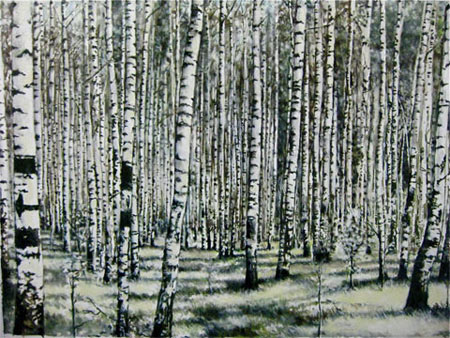
Lawrence Gipe presents a collection of paintings and drawings under the title “1962,” which happens to be the year of his birth, a detail that however the artist claims was not the determining factor in his choice of appropriated images. Rather, the press release that accompanies the show points to Soviet propaganda images published in 1962, the year that the Soviet Union possibly reached the zenith of its power.
Since the late ‘80s Gipe’s stock-in-trade has been the ironic transcription of propaganda imagery into oil paintings possessing the wan tonality of hand-tinted photographs. In the early days, irony was deployed via the addition of captions lettered directly onto the lower part of the paintings. Thus, in a series devoted to the Krupp armament industry, Gipe appended the Krupp motto: Noth kennt kein gebot (Necessity knows no laws) to noirish paintings of locomotives, reminding anyone inclined to idealize the “golden age” of train travel that those art moderne silhouettes passing each other in the night might have been transporting slave labor to Krupp’s German wartime factories.
Eventually, Gipe dropped his captions and left the burden of irony to the titles. So, a vintage postcard view of masted boats at anchor on a peaceful lake could be titled “Wannsee 1942.” Like the view? So did the Nazi planners who gathered at a local villa in January of that year to make preparations for the Final Solution.
That is eventually the price of kitsch, Gipe seemed to be intimating to his viewers, simultaneously playing on their guilt (for enjoying it) and assuaging his own (for appropriating it). But after a couple of decades of pictorially baiting his ironic hooks, the artist has also pretty much worn down the sharp points to little more than an excuse for dispensing to us the retro picturesque — always with the ironist’s alibi that the images he recycles as paintings are not to be taken at face value.
Thus, in the current show, while a painting of a stand of birch trees might easily pass for a piece of suburban kitsch, the viewer is expected to be cognizant of the birch tree’s long association with Russian lore. How would Soviet propagandists have meant the image to be understood? As symbol of collective strength? The primordial resilience of the Russian people? The impregnability of the motherland? Presumably, the picture entitled “No.5 From 1962 (Warsaw),” with its repetition of the identical facades forming a block of housing units shows the collectivist utopia as it actually looked – bleak. Another work shows a line of silhouetted figures gathered at the base of the Kremlin wall waiting their turn to gain admittance into Lenin’s tomb to glimpse the embalmed body of the Bolshevik leader. Here the artist reprises the theme of anonymous aggregation. An image of a light propeller plane flying above snow-covered mountains is harder to place, as is the painting of a woman gazing up at a grayish statue in a garden.
What all this adds up to is anybody’s guess. In a lecture delivered at the Höchschule für Bildende Kunst in Dresden, Germany last year on the topic of “Nostalgia and Ideology,” Gipe noted that “the unhappiness and disappointment that arose after Perestroika and Glasnost has (sic) produced a collective nostalgic longing for the stability of the Soviet system.”
Ah, those benighted Russians, clinging to “stability” when they could be joining the rest of us on a thrilling Back to the Future ride toward a neoliberal utopia of global sweatshops run by the friends of Thomas Friedman.
My suspicion is that Gipe’s interest in totalitarian kitsch represents a longing for academicism. As Clement Greenberg pointed out more than 70 years ago, kitsch is the continuation into modernity of the conventions of academic art.
In short, I think that under the cover of an ironic take on the nostalgia of others, Gipe has found a way to secrete his own nostalgia for the pre-modern. His pencil rendering of the face of a smiling woman next to a birch trunk (“No. 8 From 1962”), suggests that Soviet propaganda sources serve Gipe in a way not dissimilar to the way plaster casts of Greek statuary served previous generations of academic artists. What has been repressed to enable this conflation of Communism with academicism is the memory of the Soviet avant-garde of the early years of the revolution and its commitment to avoid bourgeoisie realism.
Gipe’s notion of totalitarianism, which refuses to nuance any distinction between Nazism and Communism, is a simplification that obscures the possibility that Stalinism may have had more in common with the neoliberal drive to create a “flat” world (Friedman’s term) of slave labor in service to a hollow idea of progress than with the vision of radical equality that united the Bolsheviks and the avant-garde at the moment of revolution. The image of a Tu-22 bomber flying above the clouds (“No.9 From 1962 (Fighter)”) is not quite what Malevich had in mind when in 1919 he issued the declaration, “Follow me comrade aviators. Swim in the abyss.” What Malevich wanted to destroy in the name of a higher realism was the pictorial illusionism to which Gipe remains steadfastly faithful. Nostalgia comes in different forms. And one of them is the belief that with a little bit of “irony” mixed in painting can gloss over the rupture with pictorialism that the Soviet avant-garde championed before socialist un-realism restored the ancien regime of representation.
Published courtesy of ArtScene ©2010
